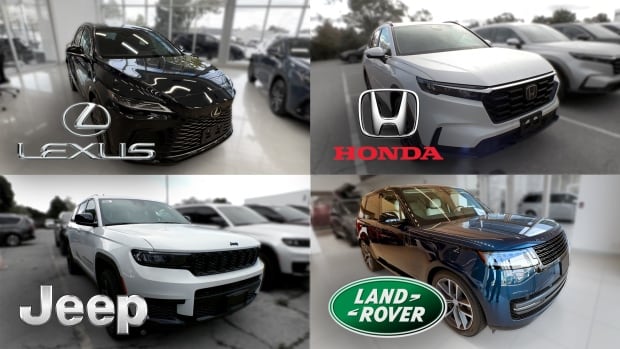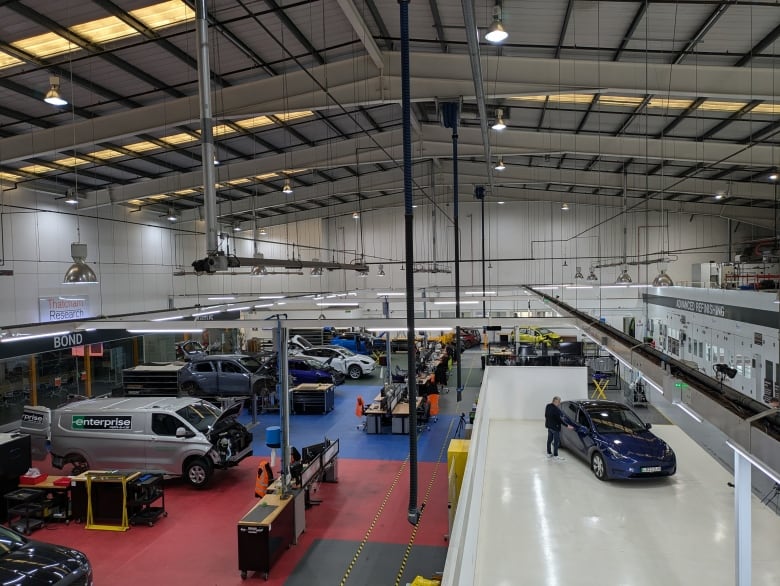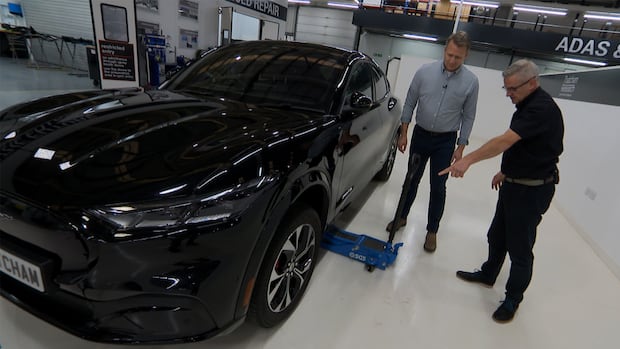
When Anuj Sethi’s Range Rover was stolen from his driveway in 2021, he says police told him it was one of six cars stolen on the same night in his Oakville, Ont., neighbourhood.
He was shocked to learn his car may have been harder for thieves to steal if he’d bought it in the U.K.
“This is completely not right. Car manufacturers should have the same security features all around the world,” said Sethi.
CBC’s Marketplace reviewed a recent report by insurance industry non-profit Equité Association of the 10 most stolen vehicles in Canada. Of those 10, six were made for roads in Canada and the United Kingdom.
When Marketplace compared features on cars sold in the U.K. with those sold in Canada, it found those six models had additional security features in the U.K. that aren’t offered on Canadian versions of the same car, which can make them harder to steal.
The 2024 U.K. models of the Jeep Grand Cherokee, Jeep Wrangler, Land Rover Range Rover, Lexus RX, Honda CR-V and Honda Civic all have tilt sensors and intrusion sensors, which do not come standard on Canadian versions of the same vehicles.
Another feature Marketplace learned is on all of the U.K. versions except the Jeep Wrangler is double locking. This feature was not on any of the Canadian models.
Despite a much smaller population than the U.K., Canada currently has a considerably higher rate of car theft, with 286.46 cars stolen for every 100,000 people, compared to just 155.96 per 100,000 people in the U.K., according to 2023 figures from Statistics Canada and the U.K.’s Driver and Vehicle Licensing Agency.
Car theft hit its peak in the U.K. in 1992 with 620,000 thefts, but in 2016, there were just 91,000, according to data from the Office for National Statistics.

Bryan Gast, who leads auto theft investigations for Canada’s insurance industry, believes that the more than 85 per cent decline in U.K. theft rates over that period can, in part, be attributed to automakers having to meet what he describes as “some of the most stringent security standards in the world.”
While car theft rates have climbed back up in the U.K., Gast says cars sold in Canada remain far too easy to steal, and automakers need to do more to prevent the vehicle from being stolen in the first place.
“When you can steal a vehicle in less than 30 seconds, there’s issues.”
Security scores push automakers in U.K. to do more
While tilt and intrusion sensors and the double locking feature Marketplace found on those U.K. models aren’t likely on their own to prevent a car from being stolen, layers of security like those can make a car more secure and more of a challenge to steal, says Steve Launchbury, principal engineer for automotive security at Thatcham Research, an insurance industry funded centre.
“We are certainly making it more and more difficult,” said Launchbury.
Located in Thatcham, England, the organization tests and scores cars for safety and security. Insurance premiums are often based on these scores.
The testing awards points for security features including intrusion and tilt sensors, as well as double locking.
An intrusion sensor triggers an alarm to sound if someone tries to reach into the vehicle. A tilt sensor triggers an alarm if the car or its tires are lifted; it’s designed to guard against theft with a tow truck. Double locking ensures the vehicle cannot be opened by breaking a window and operating the doors from the inside.
Launchbury believes the grading system Thatcham Research assigns to vehicles has put additional pressure on manufacturers to improve their cars’ security features.
He doesn’t think it’s fair to Canadian consumers that those features are missing from their models.
“Obviously, you would expect the car to be as secure as it can possibly be,” he said.
When Marketplace asked the manufacturers about the disparity in the security features, Lexus and Jeep Land Rover acknowledged the difference in regulatory requirements.
Stellantis, the company that makes Jeep vehicles, said in an email that “security measures for vehicles in the U.K. differ from those in the North American market due to [European Union] regulations.”
In emails, Lexus told Marketplace that Canadian regulations “pose a different set of challenges for manufacturers” building vehicles for the North American market.
JLR, the parent company of Land Rover, sent an email response that explained specifications and features on its vehicles vary and are “dependent on model and market.”
Canadian regulations falling behind
The last time Canada saw a significant decrease in car theft was 2007, when anti-theft regulations were last fully updated in this country.
When Marketplace asked federal Transportation Minister Anita Anand why it’s taken so long to update anti-theft regulations in Canada, she acknowledged it’s been some time but promised change is coming.
“Amending legislation does take time, but yes, we are on top of it,” Anand said.
As for a timeline for when Canadians can expect to see new regulations take effect, Anand committed to putting something on the table in 2025. “I am working on an as-soon-as-possible basis,” she said.
That long lag in updating Canada’s regulations is partly responsible for Canada’s current auto theft crisis, says Elliott Silverstein, director of government relations for CAA Insurance. Technology has evolved and so have thieves, he says, but Canada’s anti-theft standards have not.
“In the last 10 years, we have all moved to push-button start. We have all moved to other types of technology in our cars, and the standards have not kept in line with those changes,” said Silverstein.
With auto thefts surging in Canada, police and experts are urging manufacturers to make vehicles more secure, as a CBC Marketplace investigation finds that some of the most stolen models in Canada are harder to steal in the U.K., thanks to enhanced safety measures there.
He acknowledges there is no single solution to solving Canada’s auto theft crisis, but he says manufacturers have a significant role to play, and tougher regulations would pressure them to catch up.
“If we had stronger technology in our cars to prevent the cars from being stolen, thieves likely wouldn’t get access to it.”
Personalization: The future of car security?
One thing Silverstein believes regulators and automakers should consider moving forward is personalization, a security feature for cars that’s similar to two-factor authentication on a phone or other electronic device.
“We need to see some of those standards that are really becoming commonplace in society in our vehicles, because that’s an extra way to prevent the cars from being stolen,” said Silverstein.
Personalization can take different forms, such as requiring a vehicle driver to enter a PIN to start the engine. This is already being used by some car manufacturers.
Thatcham Research, which updates its security evaluation every few years to keep up with evolving trends, will be assessing cars for a personalization feature in vehicles by the end of this year.

Launchbury says the feature would be an option that consumers could choose to turn on.
“Should you feel that you’re living in an area of high crime, then this would be a significant [security] layer to introduce,” Launchbury said.
Marketplace asked Jeep, Land Rover, Lexus and Honda if Canadian consumers can expect to see personalization added as a feature. None of the manufacturers provided a response to this question.
Automakers respond
In emailed responses to Marketplace‘s investigation, Honda Canada said they are continuously reviewing and assessing vehicle technology to “stay ahead of criminals who circumvent this technology.”
In an email, Lexus said they’ve “adopted a multi-tiered approach to reducing the likelihood of our vehicles being stolen” and that they are updating their security at a “rapid pace.”
Stellantis, the maker of Jeep, said their vehicles “comply with or surpass all applicable federal safety and security standards, utilizing industry-leading vehicle security technology.”
Land Rover told Marketplace it has brought in a number of security changes in recent years and that the updates “have resulted in a dramatic decrease in theft rates of our vehicles,” although they didn’t specify where.
Anuj Sethi wasn’t willing to wait for improvements to anti-theft regulations — he just replaced his stolen Range Rover with a new car. His biggest consideration before he bought it was that it’s not on Canada’s top 10 most stolen vehicles list.
“If consumers are making decisions based on security and safety and not based on what they need and what they can afford, there’s a bit of a problem,” said Sethi.
